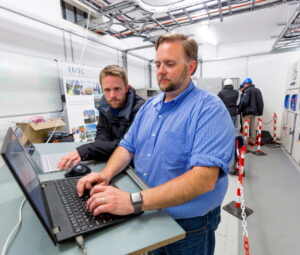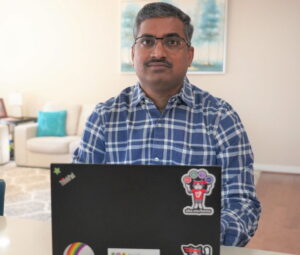When Microsoft announced its plan to build an underwater datacenter, Lathish Kumar Chaparala was excited.
“During the initial rollout of Project Natick, I used to log on to their website and watch the live feed of the underwater camera that was mounted on the datacenter,” says Chaparala, a senior program manager on the networking team in Core Services Engineering and Operations (CSEO), the engineering organization at Microsoft that builds and manages the products, processes, and services that Microsoft runs on.
Little did he know that he and his team would later be brought in to extend the network connectivity of this underwater datacenter so it could be safely fished out of the sea.
But the story begins much earlier than that.
We saw the potential benefit [of developing an underwater datacenter] to the industry and Microsoft. People responded to our work as if we were going to the moon. In our eyes, we were just fulfilling our charter—taking on challenging problems and coming up with a solution.
– Mike Shepperd, senior research and development engineer on the Microsoft Research team
The idea of an underwater datacenter came out of ThinkWeek, a Microsoft event where employees shared out-of-the-box ideas that they thought the company should pursue. One creative idea was put forth by employee Sean James, who proposed building an underwater datacenter powered by renewable ocean energy that would provide super-fast cloud services to crowded coastal populations.
His idea appealed to Norm Whitaker, who led special projects for Microsoft Research at the time.
Out of this, Project Natick was born.

“Norm’s team was responsible for making the impossible possible, so he started exploring the viability of an underwater datacenter that could be powered by renewable energy,” says Mike Shepperd, a senior research and development engineer on the Microsoft Research team who was brought on to support research on the feasibility of underwater datacenters.
It quickly became a Microsoft-wide effort that spanned engineering, research, and IT.
“We saw the potential benefit to the industry and Microsoft,” Shepperd says. “People responded to our work as if we were going to the moon. In our eyes, we were just fulfilling our charter—taking on challenging problems and coming up with solutions.”
Researchers on the project hypothesized that having a sealed container on the ocean floor with a low-humidity nitrogen environment and cold, stable temperatures would better protect the servers and increase reliability.
“Once you’re down 20 to 30 meters into the water, you’re out of the weather,” Shepperd says. “You could have a hurricane raging above you, and an underwater datacenter will be none the wiser.”
Internal engineering team steps up
The Project Natick team partnered with networking and security teams in CSEO and Arista to create a secure wide-area network (WAN) connection from the underwater datacenter to the corporate network.
“We needed the connectivity that they provided to finish off our project in the right way,” Shepperd says. “We also needed that connectivity to support the actual decommissioning process, which was very challenging because we had deployed the datacenter in such a remote location.”
In the spring of 2018, they deployed a fully connected and secure datacenter 117 feet below sea level in the Orkney Islands, just off the coast of Scotland. After it was designed, set up, and gently lowered onto the seabed, the goal was to leave it untouched for two years. Chakri Thammineni, a network engineer in CSEO, supported these efforts.

“Project Natick was my first engagement after I joined Microsoft, and it was a great opportunity to collaborate with many folks to come up with a network solution,” Thammineni says.
Earlier this year, the experiment concluded without interruption. And yes, the team learned that placing a datacenter underwater is indeed a more sustainable and efficient way to bring the cloud to coastal areas, providing better datacenter responsiveness.
With the experiment ending, the team needed to recover the datacenter so it could analyze all the data collected during its time underwater.
That’s where Microsoft’s internal engineering teams came in.
“To make sure we didn’t lose any data, we needed to keep the datacenter connected to Microsoft’s corporate network during our extraction,” Shepperd says. “We accomplished this with a leased line dedicated to our use, one that we used to connect the datacenter with our Microsoft facility in London.”
The extraction also had to be timed just right for the same reasons.
“The seas in Orkney throw up waves that can be as much as 9 to 10 meters high for most of the year,” he says. “The team chose this location because of the extreme conditions, reasoning it was a good place to demonstrate the ability to deploy Natick datacenters just about anywhere.”
And then, like it has for so many other projects, COVID-19 forced the team to change its plans. In the process of coming up with a new datacenter recovery plan, the team realized that the corporate connectivity was being shut down at the end of May 2020 and couldn’t be extended.
“Ordering the gear would’ve taken two to three months, and we were on a much shorter timeline,” Chaparala says.
Shepperd called on the team in Core Platform Engineering, a division of CSEO, to quickly remodel the corporate connectivity from the Microsoft London facility to the Natick shore area, all while ensuring that the connection was secured.
The mission?
Ensure that servers were online until the datacenter could be retrieved from the water, all without additional hardware.

“My role was to make sure I understood the criticality of the request in terms of timeline, and to pull in the teams and expertise needed to keep the datacenter online until it was safely pulled out of the water,” Chaparala says.
The stakes were high, especially with the research that was on the line.
“If we lost connectivity and shut down the datacenter, it could have compromised the viability of the research we had done up until that point,” Shepperd says.
A seamless collaboration across Microsoft Research and IT
To solve this problem, the teams in Core Platform Engineering and Microsoft Research had to align their vision and workflows.
“Teams in IT might plan their work out for months or years in advance,” Shepperd says. “Our research is on a different timeline because we don’t know where technology will take us, so we needed to work together, and fast.”
Because they couldn’t bring any hardware to the datacenter site, Chaparala, Thammineni, and the Microsoft Research team needed to come up with a network redesign. This led to the implementation of software-based encryption using a virtual network operating system on Windows virtual machines.
It’s exciting to play a role in bringing the right engineers and program managers together for a common goal, especially so quickly. Once we had the right team, we knew there was nothing we couldn’t handle.
– Chakri Thammineni, a network engineer in Core Services Engineering and Operations
With this solution in tow, the team could extend the network connectivity from the Microsoft Docklands facility in London to the Natick datacenter off the coast of Scotland.
“Chakri and Lathish have consistently engaged with us to fill the gaps between what our research team knew and what these networking experts at Microsoft needed in order to take action on the needs of this project,” Shepperd says. “Without help from their teams, we would not have been able to deliver on our research goals as quickly and efficiently as we did.”
Lessons learned from the world’s second underwater datacenter
The research on Project Natick pays dividends in Microsoft’s future work, particularly around running more sustainable datacenters that could power Microsoft Azure cloud services.
“Whether a datacenter is on land or in water, the size and scale of Project Natick is a viable blueprint for datacenters of the future,” Shepperd says. “Instead of putting down acres of land for datacenters, our customers and competitors are all looking for ways to power their compute and to house storage in a more sustainable way.”
This experience taught Chaparala to assess the needs of his partner teams.
“We work with customers to understand their requirements and come up with objectives and key results that align,” Chaparala says.
Ultimately, Project Natick’s story is one of cross-disciplinary collaboration – and just in the nick of time.
“It’s exciting to play a role in bringing the right engineers and program managers together for a common goal, especially so quickly,” Chaparala says. “Once we had the right team, we knew there was nothing we couldn’t handle.”






















